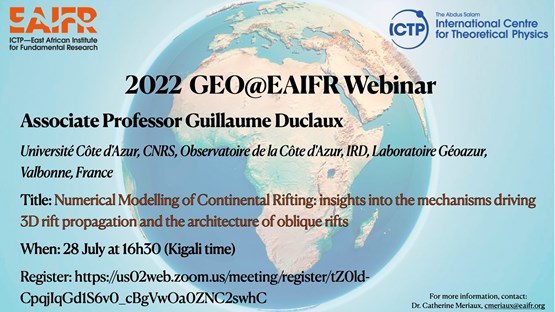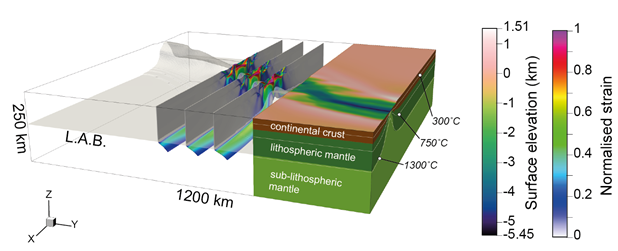ICTP-East African Institute for Fundamental Research
KIST2 Building CST
Nyarugenge Campus
University of Rwanda
Kigali, Rwanda
GEO@EAIFR Webinar Series 2022
Associate Professor Guillaume Duclaux will discuss numerical modelling of continental rifting.

The East African Institute for Fundamental Research (EAIFR) and the International Centre for Theoretical Physics (ICTP) wish to inform those who may be interested of a GEO@EAIFR webinar. This seminar will take place on July 28, 2022 and will be broadcast live on ZOOM. It will also be recorded and later posted on the ICTP-EAIFR YouTube channel, where one can find the previous recorded GEO@EAIFR webinars. Below all the details:
Speaker: Associate Professor Guillaume Duclaux, Université Côte d'Azur, CNRS, Observatoire de la Côte d'Azur, IRD, Laboratoire Géoazur, Valbonne, France
Title: Numerical Modelling of Continental Rifting: insights into the mechanisms driving 3D rift propagation and the architecture of oblique rifts.
When: July 28, 2022 at 16:30 (Kigali time).
Register in advance for this meeting by clicking here.
All are very welcome.
Biography:
Dr. Guillaume Duclaux is currently an Associate Professor in tectonics at the Université Côte d'Azur, in Nice, France. He studied geosciences at the Ecole Normale Supérieure in Lyon and obtained a PhD in tectonics from the University of Saint Etienne, in France, and the University of Sydney, in Australia in 2007. His research then focused on the mechanical behaviour of Precambrian orogens. After graduating, Guillaume worked as a research scientist with the CSIRO in Australia for 7 years where he applied his skills in structural geology, computational tectonics, and surface processes modelling to develop new solutions to mineral exploration problems. In 2014 he joined the Geodynamics Group at the University of Bergen in Norway as a research fellow to study continental rift dynamics. He moved back to France in 2017 as Faculty at the University in Nice. Guillaume has also worked as a senior geoscientist consultant with various large mining companies in Australia and Africa, assisting exploration geologists with combining geological, geochemical and geophysical data, and testing exploration models through cutting edge numerical modelling methods.
Abstract:

The formation and evolution of continental rift systems and passive margins are of primary interest to both academics and the industry. Processes involved in the development of rift basins in extensional settings span across a wide range of spatial and temporal scales. During this presentation, I intend to illustrate through a series of examples, compared to field analogues, how numerical modelling can help geoscientists decipher the complex signals associated with tectonic processes in active and ancient rift systems.
This journey through rift modelling will start at the very large scale, with an overview of the potential of 3D lithospheric-scale thermo-mechanical modelling to address questions about the mechanisms driving rift propagation on Earth, as well as improving our understanding of the structural architecture of oblique rift systems. Then, we shall look more closely at the development of extensional structures in continental rift basins and assess the influence of normal faults’ geometry on surface's uplift and subsidence in such system. This journey will conclude at the Earth's surface where Landscape Evolution Models have been used to study the dynamic surface response to extensional tectonics in terms of drainage evolution and sediment budget shifts.



